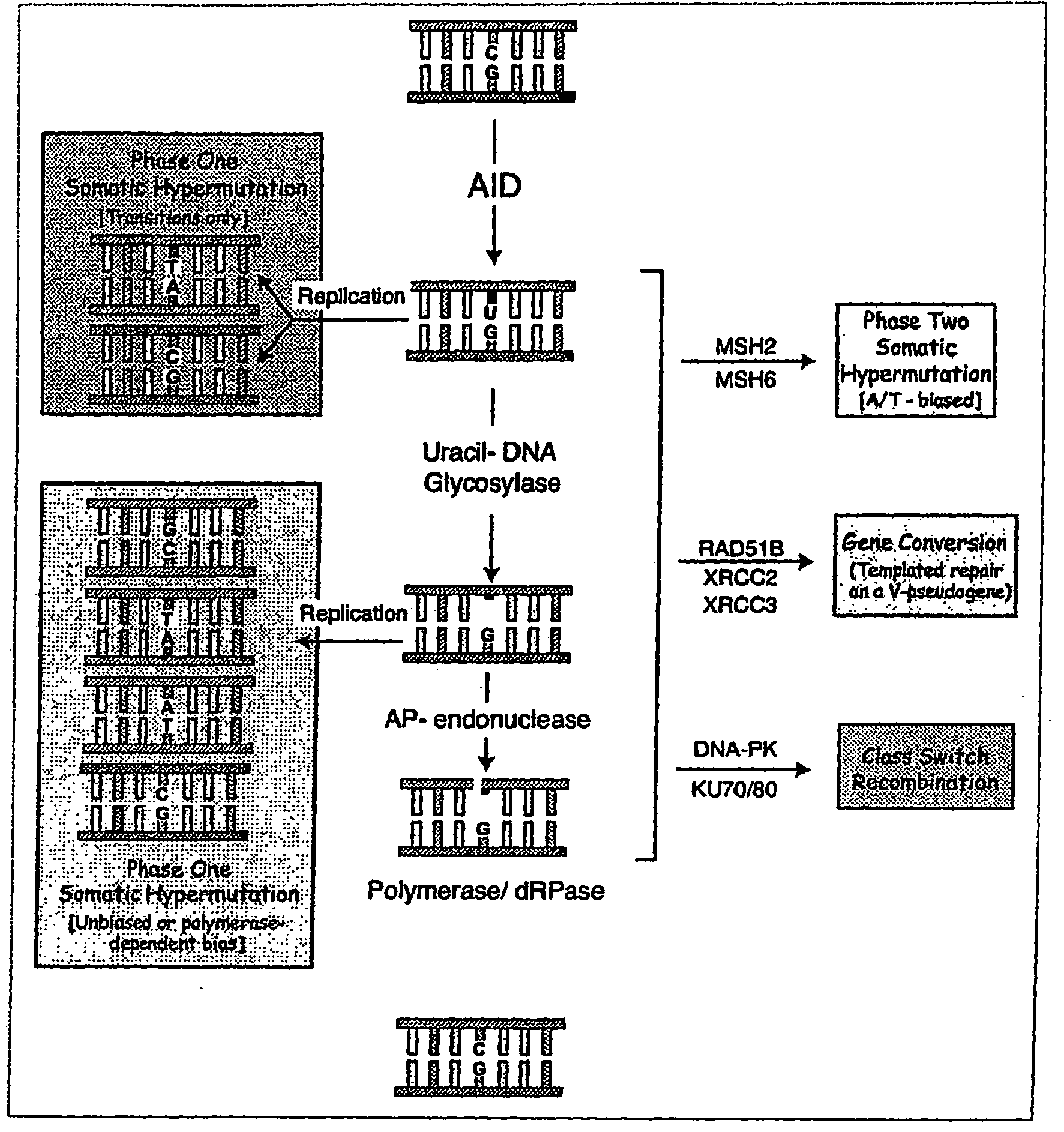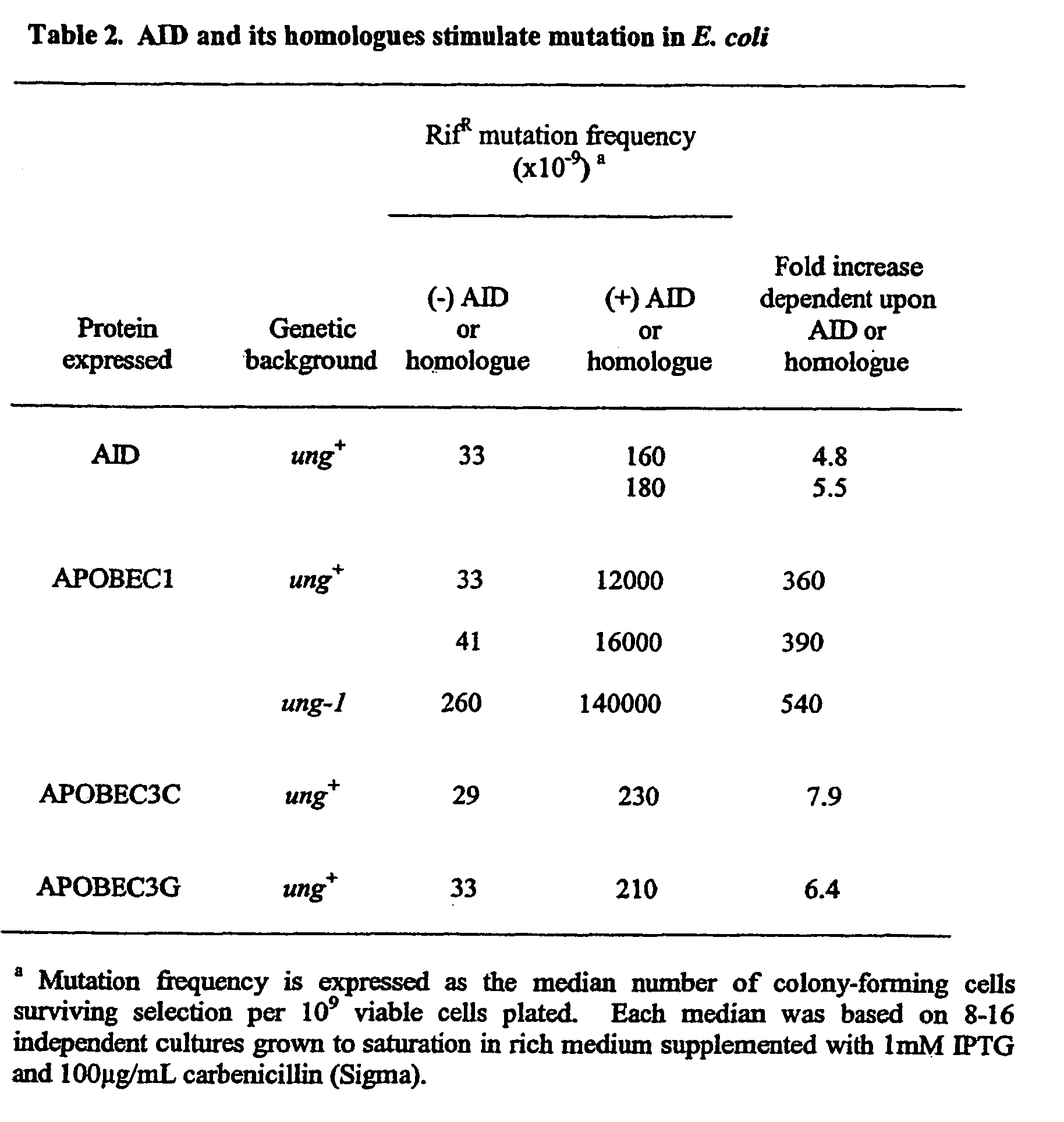Activation induced deaminase (AID)
a technology aide, which is applied in the field of activation induced deaminase, can solve the problems of enhancing the mutation rate of non-antibody producing cells, allowing the nucleotide, and not being known, and achieves the effect of enhancing the mutation frequency
- Summary
- Abstract
- Description
- Claims
- Application Information
AI Technical Summary
Benefits of technology
Problems solved by technology
Method used
Image
Examples
example 1
[0177] A plasmid containing a human AID cDNA expressed under control of the lac promoter was transformed into E. coli strain KL16 and its effect on the frequency of mutation to rifampicin-resistance (RifR) measured by fluctuation analysis (FIG. 2 and Table 1).
[0178] The AID expression plasmid was generated by cloning the human AID cDNA (Harris et al. (2002)) on an NcoI-HindIII fragment into pTrc99A (Pharmacia; gift of R. Savva). E. coli strains KL16 (Hfr(PO45) relA1 spoT1 thi-1) and its ung-1 derivative (BW310) as well as AB1157 and its nfi-1::cat derivative (BW1161) were from B. Weiss; GM1003 (dcm-6 thr-1 hisG4 leuB6 rpsL ara-14 supE44 lacY1 tonA31 tsx-78 galK2 galE2 xyl-5 thi-1 mtl-1 mug::mini-Tn10) derivatives carrying ung-1 and / or mug::mini-Tn10 mutations were from A. Bhagwat.
[0179] APOBEC1 and APOBEC2 expression constructs were generated by subcloning the rat APOBEC1 cDNA (BamHI-HSalI fragment of pSB20227 gift from N. Navaratman and J. Scott) or the human APOBEC2 cDNA (NcoI-B...
example 2
APOBEC1 Expressed in E. coli can be Used to Mutate a Heterologous Gene Integrated into the Chromosome.
[0197] The Bacillus subtilis gene SacB is toxic to E. coli in the presence of sucrose. SacB is cloned under the control of the E. coli promoter for PhoB and the cassette integrated into the chromosome of E. coli strain DH10b at the Lambda phage attachment site using pRB700 (FIG. 8a), a derivative of the CPJM system plasmid pSK50Δ-uidA2 (Haldimann et al 1996 Proc Natl Acad Sci USA. 93(25):14361-6, Haldimann and Wanner 2001 J. Bacteriol. 183(21):6384-93). The PhoB promoter is active under conditions of low inorganic phosphate availability. Thus mutants in the SacB cassette can be selected by growing independent colonies transfected with either an APOBEC1 expression construct or a control plasmid to saturation (using one fortieth of the colony as the inoculum) and plating on minimal MOPS medium containing 5% sucrose and limiting phosphate.
[0198] PCR and subsequent sequencing of the ...
example 3
Deamination of Cytosine to Uracil in DNA can be Achieved in Vitro Using Partially Purified APOBEC1 from Extracts of Transformed Escherichia coli.
Plasmids and Bacteria
[0203] The pTrc99- and pET-based expression vectors for rat APOBEC1 and its B63->A mutant, for human APOBEC2 and for E. coli dCTP deaminase as well as the E. coli host strains have been described previously (Rada et al. (2002) Curr. Biology 12, 1748-1755, Randerath K., and Randerath E. (1967) Method Enzymol. 12, 323-347). The pTrc99- and pET-based vectors differ both in the nature of the promoter used (pTrc99 uses the trp / lac hybrid promoter whereas pET uses the T7 promoter) and in the length of heterologous peptide linked to the amino-terminus of the recombinant protein (9 amino acid with pTrc99 but 34 amino acid with pET (Rada et al. (2002) Curr. Biology 12, 1748-1755., Randerath K., and Randerath E. (1967) Method Enzymol. 12, 323-347)).
Oligodeoxyribonucleotides
[0204] The oligodeoxyribonucleotides used are list...
PUM
| Property | Measurement | Unit |
|---|---|---|
| Electrical resistance | aaaaa | aaaaa |
| Gene expression profile | aaaaa | aaaaa |
Abstract
Description
Claims
Application Information
 Login to View More
Login to View More - R&D
- Intellectual Property
- Life Sciences
- Materials
- Tech Scout
- Unparalleled Data Quality
- Higher Quality Content
- 60% Fewer Hallucinations
Browse by: Latest US Patents, China's latest patents, Technical Efficacy Thesaurus, Application Domain, Technology Topic, Popular Technical Reports.
© 2025 PatSnap. All rights reserved.Legal|Privacy policy|Modern Slavery Act Transparency Statement|Sitemap|About US| Contact US: help@patsnap.com



